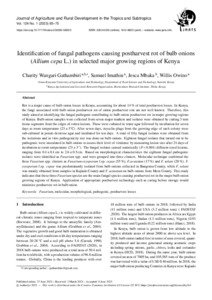Identification of fungal pathogens causing postharvest rot of bulb onions (Allium cepa L.) in selected major growing regions of Kenya
| dc.date.accessioned | 2023-06-29T07:34:50Z | |
| dc.date.available | 2023-06-29T07:34:50Z | |
| dc.date.issued | 2023-06-27 | |
| dc.identifier | doi:10.17170/kobra-202306128203 | |
| dc.identifier.uri | http://hdl.handle.net/123456789/14857 | |
| dc.language.iso | eng | eng |
| dc.rights | Namensnennung 4.0 International | * |
| dc.rights.uri | http://creativecommons.org/licenses/by/4.0/ | * |
| dc.subject | fusarium | eng |
| dc.subject | molecular | eng |
| dc.subject | morphological | eng |
| dc.subject | pathogenic | eng |
| dc.subject | postharvest losses | eng |
| dc.subject.ddc | 630 | |
| dc.title | Identification of fungal pathogens causing postharvest rot of bulb onions (Allium cepa L.) in selected major growing regions of Kenya | eng |
| dc.type | Aufsatz | |
| dcterms.abstract | Rot is a major cause of bulb onion losses in Kenya, accounting for about 14 % of total postharvest losses. In Kenya, the fungi associated with bulb onion postharvest rot of onion postharvest rots are not well known. Therefore, this study aimed at identifying the fungal pathogens contributing to bulb onion postharvest rot in major growing regions of Kenya. Bulb onion samples were collected from seven major markets and isolates were obtained by cutting 3 mm tissue segments from the edges of rotten lesions. These were cultured in water agar followed by incubation for seven days at room temperature (23 ± 3℃). After seven days, mycelia plugs from the growing edge of each colony were sub-cultured in potato dextrose agar and incubated for ten days. A total of fifty fungal isolates were obtained from the isolations and in vitro pathogenicity test was done on bulb onions. Eighteen fungal isolates that turned out to be pathogenic were inoculated in bulb onions to assess their level of virulence by measuring lesion size after 21 days of incubation at room temperature (23 ± 3℃). The fungal isolates caused statistically (P<0.001) different sized lesions, ranging from 0.4±0.1 cm to 2.6±0.5 cm. Based on morphological characteristics the eighteen fungal pathogenic isolates were identified as Fusarium spp. and were grouped into three clusters. Molecular technique confirmed the three Fusarium spp. clusters as Fusarium oxysporum f.sp. cepae (55%), F .acutatum (17%) and F. solani (28%). F. oxysporum f.sp. cepae was predominantly isolated from bulb onions collected in Bungoma County, while F. solani was mainly obtained from samples in Kajiado County and F. acutatum on bulb onions from Meru County. This study indicates that these three Fusarium species are the main fungal species causing postharvest rot in the major bulb onion growing regions of Kenya. Application of appropriate postharvest technology such as curing before storage would minimize postharvest rot in bulb onion. | eng |
| dcterms.accessRights | open access | |
| dcterms.creator | Gathambiri, Charity Wangari | |
| dcterms.creator | Imathiu, Samuel | |
| dcterms.creator | Mbaka, Jesca | |
| dcterms.creator | Owino, Willis | |
| dc.subject.swd | Kenia | ger |
| dc.subject.swd | Küchenzwiebel | ger |
| dc.subject.swd | Pathogene Pilze | ger |
| dc.subject.swd | Fusarium | ger |
| dc.subject.swd | Molekülstruktur | ger |
| dc.subject.swd | Morphologie <Biologie> | ger |
| dc.subject.swd | Ernteverlust | ger |
| dc.subject.swd | Fäulnis | ger |
| dc.type.version | publishedVersion | |
| dcterms.source.identifier | eissn:2363-6033 | |
| dcterms.source.issue | No. 1 | |
| dcterms.source.journal | Journal of Agriculture and Rural Development in the Tropics and Subtropics (JARTS) | eng |
| dcterms.source.pageinfo | 65-75 | |
| dcterms.source.volume | Vol. 124 | |
| kup.iskup | false |
Dateien zu dieser Ressource
Das Dokument erscheint in:
-
Vol 124, No 1 (2023) [10]


